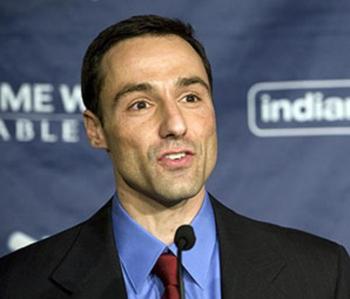 Indians Archive
Indians Archive  Extending the Cynicism
Extending the Cynicism
 If anyone other than Cleveland Indians general manager Chris Antonetti and team president Mark Shapiro had made the decisions to "extend" the contracts of Carlos Santana and Asdrubal Cabrera, I'd buy into it easier. As it is, when these two conspire to sign younger players to what are being called contract extensions, fans would do well to look at little more closely, mainly because with these two it's rarely as it seems.
If anyone other than Cleveland Indians general manager Chris Antonetti and team president Mark Shapiro had made the decisions to "extend" the contracts of Carlos Santana and Asdrubal Cabrera, I'd buy into it easier. As it is, when these two conspire to sign younger players to what are being called contract extensions, fans would do well to look at little more closely, mainly because with these two it's rarely as it seems.
Shapiro is a disciple of John Hart. Antonetti in turn is a disciple of Shapiro. Behind Antonetti is no doubt so acolyte that will also be a lesser light. In the Indians' general manager, where inbreeding of its executive think is preferred, the generations are getting progressively weaker not stronger.
When Hart took a flyer on signing younger players to contract extensions, it was innovative. With an eye for talent, Hart singled out good young players and actually did make a financial commitment to them in a way no one else was doing at the time but in the same way that the Jacobs-owned Indians actually made commitments to legitimate free agents.
As the money has dried up under the Dolans' ownership, the challenges have been greater and Shapiro, a generation removed from Hart, has never quite been up to the task. The best that can charitably be said about his tenure as general manager is that it was uneven, from questionable trades to questionable extensions with a few outright successes to keep the fans guessing.
I could rail about how Shapiro has taken a gift for gab and clipped speech and turned it into a career without actually having accomplished anything too meaningful on the field, but why rail about that? Fans already know that the Indians won the division in 2007 with Shapiro ostensibly in charge and have been awful ever since as he tinkered and tortured his way to creating a machine that can smoothly deliver a crap sandwich season after season.
Now comes still another generation removed in the form of Antonetti. Until Santana and Cabrera were signed to their "extensions" the Indians looked suspiciously like a team that was deliberately avoiding putting players under anything other than a one-year contract.
I could rail about how Antonetti, armed with statistics, helped make a mess of the Indians player development process when he was Shapiro's first lieutenant, but why rail about that, either? Fans can see the fruits of his efforts each night as they gnaw through the imaginary phone telephone cords of the landlines they once owned bemoaning Antonetti's inability to a) grow any meaningful talent through the draft and b) find meaningful help through questionable trades or in the cutout section of the flea market he shops every off season.
So when the announcement came that the Indians had signed Santana to an "extension" similar to that given to Cabrera, I didn't know whether to get cynical or skeptical but I knew it had to be one or the other. It turns out that either will do.
The cynic in me believes that Santana was signed to an extension mainly on the strength of his two home-run performance in the team's only win this season and the fact that he's beating the cover off the ball in comparison to rest of his teammates at the inglorious pace of a .250 average. But the skeptic in me knows better. When it comes to making decisions about players the Indians move roughly at the pace of a governmental agency so the chance that Santana's "hot" start factored into current thinking is minimal.
Really, though, it doesn't take a professional cynic or skeptic to see through the veneer of these extensions as less about a commitment to spending money to retain valuable assets and more about an opportunity for team and player to hedge their bets.
A player with at least three years of service is eligible for salary arbitration. He isn't eligible for free agency until after his sixth year. In the cases of Santana and Cabrera, the contract extensions, such as they are, buy the Indians certainty through the arbitration years while providing the players a launching pad for their inevitable trade somewhere else in that last year of their contracts should their performance meet or exceed expectations.
Because if there's anything worse to the Indians then a player underperforming his contract, it's a player on the brink of free agency outperforming his contract.
This is the kind of transaction that garners Shapiro the admiration of his fellow team presidents at the off season meetings and earns knowing nods to Antonetti from his counterparts in opposing press boxes each night. But don't believe for a moment that it represents a change in direction for the team or the ones paying the bills. These extensions add no clarity to finding the answer to the inevitably frustrating question of whether or not this team will ever be properly funded to be truly competitive.
 Don't take my word for it, just be a student of history. The Indians under Shapiro have been bloodless in trading away talented fan favorites during their free agent seasons rather than pursue them to what would be true contract extensions. Shapiro first and now Antonetti understand the financial limits of their bosses and thus have laid the groundwork where it's now accepted orthodoxy that the Indians can't outbid any other team for the services of a player they grew and nurtured.
Don't take my word for it, just be a student of history. The Indians under Shapiro have been bloodless in trading away talented fan favorites during their free agent seasons rather than pursue them to what would be true contract extensions. Shapiro first and now Antonetti understand the financial limits of their bosses and thus have laid the groundwork where it's now accepted orthodoxy that the Indians can't outbid any other team for the services of a player they grew and nurtured.
In truth, it's a choice the Indians have made not to pursue high priced talent and not an inevitability thrust upon them by the baseball Gods or the economy. The operations of the Detroit Tigers prove that point.
Nonetheless, I've long since reconciled myself to this method of operation as most fans have. What's frustrating though is for the Indians to try to treat these fans as some sort of idiots who cannot see through the simple pretense of the frugal way in which they choose to operate a franchise designed not to win but to turn a decent profit for the owner irrespective of performance.
Knowing that they couldn't lose Santana and Cabrera for most of the periods through which they're now signed, these new contracts don't represent extensions as much as they represent agreed upon financial hedges against the vagaries of the arbitration process.
The problem with the arbitration process for the Indians is that it represents disorder to the anal-retentive way in which they like to operate. It almost doesn't matter what kind of year the player had because arbitration only enriches, it never cuts. So no matter how either Cabrera or Santana performs during one of their arbitration years, they know they'll get a raise with the only question being how much.
Since Shapiro likes to plan his 5-year operating budget down to the number of light bulbs that will be needed in the overhanging lamp in his office, it's unfathomable to him to not know what number to plug into his budget for Cabrera's or Santana's salary in those years, particularly should Cabrera or Santana actually put together a good season.
Now these so-called extensions give Shapiro and Antonetti real budget certainty on two of their better players, allowing them to focus elsewhere. This isn't really a criticism because having budget certainty is pretty important to any multi-million dollar business.
But creating budget certainty is not a proxy for commitment and the Indians have no more or less of a commitment to either player today then they had for them before the extensions were signed.
What I'm less certain about is why Santana or Cabrera signed on. They would get their money anyway. At best these new contracts, particularly for that first free agency year, represent an insurance policy against injury or really bad performance. Since neither are pitchers, I'm not sure that trade off makes sense in either case and I suspect that the agents won't outlive these deals.
Perhaps that's the real talent of Shapiro and Antonetti. They took a good deal for them and convinced the agents that it was a good deal for their clients. Not bad, when you think about. Now if Shapiro and Antonetti could just find a way to exercise that talent in a way that actually improves the team, by say, signing a free agent that can actually hit.
- NBA Announces 2013-2014 Schedule
- Browns Ink Sharknado
- Sharknado A No-Show For Rookie Camp
- Trent Richardson Out Until Training Camp
- Browns Sign Brandon Jackson
- Carrasco Suspended Eight Games
- Browns Add to Wide Receiver Depth with David Nelson
- Browns Need to Learn from Past Draft Mistakes
- Browns Release Chris Gocong and Usama Young
- Browns Missing on Grimes Disappointing, But Not The End
The TCF Forums
- Chris Grant's first 3 drafts
Kingpin74 (Tuesday, January 21 2014 10:13 AM) - The 2014 Offseason Thread
googleeph2 (Tuesday, January 21 2014 9:36 AM) - 2015 Recruiting
furls (Tuesday, January 21 2014 6:57 AM) - Mike Brown
YahooFanChicago (Monday, January 20 2014 11:15 PM) - Movies coming out
HoodooMan (Monday, January 20 2014 9:34 PM) - 2014 Hoops Hockey Hijinx
jpd1224 (Monday, January 20 2014 4:44 PM) - 2014 Recruiting
jclvd_23 (Monday, January 20 2014 2:26 PM) - Wish List - #4 Pick
Hikohadon (Monday, January 20 2014 1:26 PM) - Official- Browns Coach Search/Rumors
OldDawg (Sunday, January 19 2014 6:48 PM) - #1 overall pick Anthony Bennett
TouchEmAllTime (Sunday, January 19 2014 1:28 PM)


